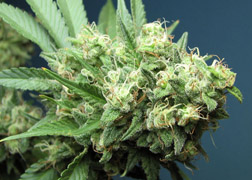
KINGSTOWN, St. Vincent – This multi-island nation, famed for its fertile soil, “continues to be the source for the majority of cannabis in the region”, according to a U.S. report on illegal drugs.
The U.S. State Department, in its 2012 International Narcotics Control Strategy Report, published earlier this month, cited Vincentian officials as saying that local marijuana producers have recently started labelling their product for export.
“Police have also observed a trend of younger nationals entering the trade,” the report said, adding that regional trade has increased with oil-rich Trinidad and Tobago.
According to the report, Vincentian drug runners and Trinidadian criminals have been exchanging marijuana for guns.
“Officials describe a marked increase in remittance flows,” the report further said, citing officials as saying that the country has 300 acres under marijuana cultivation.
The acreage cited in the report is 50 less than the 350 acres of bananas – the nation’s main agricultural crop – to be culled because of disease.
“During 2011, government officials encountered no drug laboratories, yet eradicated 70 acres of marijuana, destroyed 1,696,021 plants and seized 10.2 metric tonnes of cannabis, 39 kilogrammes (85.8 lbs) of cocaine and 180 cocaine rocks,” the report said.
Last year, the Dr. Ralph Gonsalves Unity Labour Party administration reported 522 drug related prosecutions, 322 convictions, and 432 persons arrested for drug offenses.
“Police officials say they need more vehicles, equipment, training and logistical support for their operations to be effective. Narcotics play a major role in the economy, causing a dependence on cannabis in large population segments,” the report said.
It further said that “government officials have stated they cannot combat the long terms effects of the drug trade solely through enforcement.
“DARE (Drug Abuse Resistance Education) programmes are employed in schools, but does not have rehabilitation clinics. Officials estimate 30 per cent of domestic drug abusers use cannabis while 2 per cent use cocaine,” the report further stated.
It noted, however, that the government of St. Vincent and the Grenadines is drafting a National Drug Plan with assistance from the Organization of American States and has set up a new Forensic Drug Laboratory.
The report spoke of cross-unit cooperation by local police to fight drug trafficking and abuse, adding that significant developments last year included the arrest of a trafficker with four kilogrammes (8.8 lbs) of cocaine and money laundering charges against a previously identified target.
This country is party to several international and regional drug conventions, the report further noted.
NOTE: The headline and content of an earlier version of this story said that SVG was the main source of marijuana in “the Caribbean”. That has been edited to read “the region”, in keeping with the exact text of the report.





